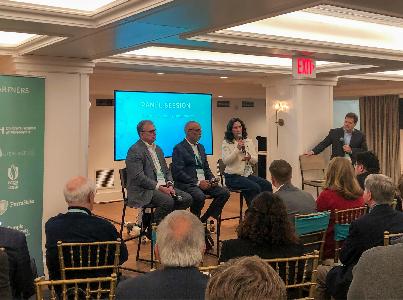
Technical.ly is one of 20+ news organizations producing Broke in Philly, a collaborative reporting project on solutions to poverty and the city’s push toward economic justice.
The last few months of uncertainty and protests have highlighted the inequality that casts a shadow over our city and country. From COVID-19 infection rates to police brutality, Philadelphia’s Black community is being attacked by two pandemics: one an acute health crisis, and the other a much more insidious disease of racial oppression.
Earlier this year, I penned an article for Billy Penn about the workforce impact of COVID-19. In that article, I posed a question of “What does it mean for a community to bear the brunt of the workforce fallout from the pandemic?”
Building on that work, I here pose a different set of questions: How do we see racial oppression manifest itself in workforce and hiring practices? How can employers help mitigate this impact? Undoing the systemic oppression of the last several centuries will involve placing racial equity front and center in workforce practices, and I suggest a few ways that employers in the Philadelphia region can do this.
To unpack this narrative, I draw again from research the Economy League of Greater Philadelphia and Philadelphia Works (PW) did for the Lenfest North Philadelphia Workforce Initiative (LNPWI).
Our research shows North Philadelphia’s tremendously diverse community is 48.5% Black. Of those residents, just over a third (34%) hold an associate’s degree or higher, in contrast to North Philly’s white population, where 41% of individuals do. We also know that lack of access to digital tools and services is a pervasive challenge, and that the majority of job postings have high educational attainment requirements.
These factors lead directly into job disparity: North Philadelphia’s Black population is employed at a rate 15% lower than the area’s white population which is employed at 55%. Qualitative studies also show lack of access to supportive services like childcare and transportation are a barrier. Further, 26% of the returning citizens in the city of Philadelphia reside in North Philadelphia.
Employers can directly address this by placing racial equity front and center in hiring and workforce development practices. Here are five concrete ways to start:
1. Only list educational attainment as a job requirement when absolutely necessary.
A common human resource practice is to place educational attainment directly within a job description — for example: “college degree required” — and then use it as a proxy to “weed out” prospective candidates. As demonstrated by our research for LNPWI, a requirement higher than an associate’s degree would automatically exclude the majority of North Philadelphia residents from even competing for jobs they may well be eligible and suited for.
Employers should use educational requirements with discretion. Sure, there may be times when specific qualifications are absolutely necessary. But you can look for opportunities where they may not be necessary at the first step of the hiring process — and remove them.
2. Provide support for employees outside of the workplace.
Qualitative evidence from our work with the LNPWI cites lack of access to supportive services as the primary barrier to work for people living in North Philadelphia. Reliable and affordable childcare, a predictable but flexible work schedule, accessible and reliable transportation, and health benefits are all major hurdles to being an effective participant in the workforce.
Assess how your company structurally accommodates for each of these topics and adjust your internal policies and practices accordingly.
3. Conduct an assessment of how your organization engages with returning citizens.
A criminal record is too often one of the major barriers to sustainable employment, a challenge that affects primarily Black and brown individuals in Philadelphia. Fully untangling the scope of this issue is deeply complex, but employers can consider a few options to make their workforce practices more inclusive:
Develop relationships with workforce organizations that serve returning citizens.
Often, these partners will help returning citizens navigate the complexities of returning home from prison, as well as connect them to resources they need. This allows you to offer an additional layer of support.
Consult your organization’s attorneys and conduct an honest assessment of how your organization uses background checks.
Background checks play an important role for both workers and communities, and are used in a variety of legitimate settings, like when teachers and school administrators are screened to work with or around children. In other instances, background checks can be unfairly wielded, or dissuade individuals from applying to positions they are qualified for. Despite some effective legal safeguards for individuals with a criminal record, North Philadelphia residents still overwhelmingly cite background checks as a major barrier to obtaining employment. Too often a criminal record is a barrier to employment, and unfortunately, the reality here in Philadelphia — and across the country — is that many individuals with a criminal record are Black.
4. Engage the community when recruiting and hiring.
A large percentage of recruiting and hiring today occurs via centralized, web-based hiring platforms. This presents a major problem for communities of color, as they experience lower rates of digital literacy and less access to digital services. Closing the digital divide is a complex endeavor that will take a heavy lift from multiple stakeholders. In the interim, there are steps employers can take to help mitigate this challenge and reach a broader audience.
If your current hiring and recruiting practices consist only of a centralized web-based application system, consider additional advertising job openings via place-based job fairs, community organizations and community-based publications.
5. Be an active participant in creating workforce development trainings.
Employer engagement with workforce development organizations is cited as one of the most effective ways to create both effective trainings and talent pipelines. If your organization does not currently partner with one, consider fostering those relationships to help create more inroads into your organization for Black residents.
###
As the region gets back to work, focusing on racial equity in hiring practices can help support and uplift the city’s Black community — a community that has borne the brunt of two pandemics. Untangling these systems of racial oppression will take years and significant investment, along with complex input from stakeholders.
However, this dual crisis presents an opportunity to rebuild a more sustainable and equitable workforce system that is deeply inclusive of all Philadelphians.
For further reading:
- 5 big ideas about the future of hiring and workforce development
- Economy League is examining how the pandemic will affect Philly and its workers
Join the conversation!
Find news, events, jobs and people who share your interests on Technical.ly's open community Slack

Philly daily roundup: Women's health startup wins pitch; $204M for internet access; 'GamingWalls' for sports venues

Philly daily roundup: East Market coworking; Temple's $2.5M engineering donation; WITS spring summit

Philly daily roundup: Jason Bannon leaves Ben Franklin; $26M for narcolepsy treatment; Philly Tech Calendar turns one


